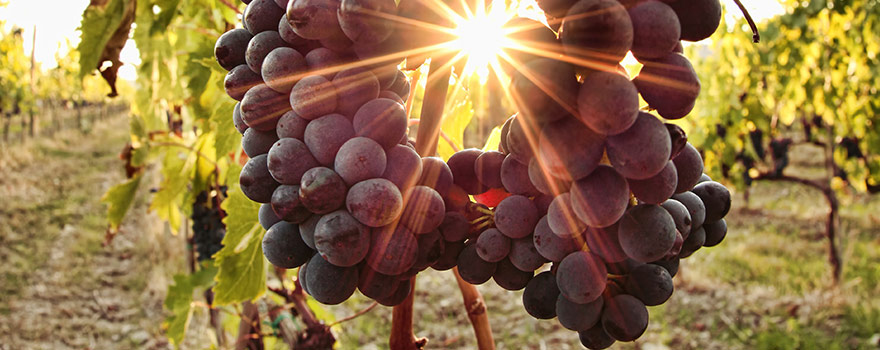
The aim of blending is to make a whole wine that is greater than the sum of its parts. Some grape varieties, like Cabernet Sauvignon and Merlot share a great synergy. On some occasions other unlikely combinations of grape varieties may complement each other beautifully, these blends may be exclusive to a single region or even a producer. Sometimes grapes are blended with other fruit from other regions to produce a wine of greater balance and complexity. In Australia, there are two main red grape varieties that form the base of most red blends – Shiraz and Cabernet Sauvignon and these are often blended together.
Cabernet Sauvignon ripens late, and that is the principal reason it is planted with the earlier ripening Merlot in Bordeaux; as an insurance policy for growers, the bonus is that the two make great blending partners. Cabernet Sauvignon’s firm tannin structure ensures that it’s capable of producing wines with good potential to improve with cellaring.
Cabernet Sauvignon is more often than not blended with one or several other grapes. Cabernet Sauvignon’s firm structure and blocky tannins can see it unapproachable in its youth. The tannins push the flavour load towards the back of the palate, leaving a flat middle that can easily be filled in by other blending partners. In Australia, apart from Shiraz, Cabernet Sauvignon’s main blending partner is usually Merlot, as it is in Bordeaux, sometime along with lesser amounts of Cabernet Franc, Malbec and Petit Verdot. Each of these blending partners brings something unique to Cabernet-based blends. Merlot adds flesh and middle palate richness, along with plum and violet characters and a silky texture. Cabernet Franc gives an aromatic lift and tight pepper, spice and red berry characters. Malbec gives palate weight, dark fruit flavours and dusty tannins. Petit Verdot adds fragrance and rich dark fruit flavours that stiffen up the middle palate. The winemaker’s objective with blending is to make a wine with greater balance, complexity, intensity and length.
Australian Shiraz makes a great red blending partner, as its ripe, open nature has many flavour and texture options that are multiplied exponentially by the variety of regions and blending possibilities. There are many Shiraz Grenache blends now available and many feature Mourvèdre. These Rhône partners work well to make medium to full-bodied wines that are spicy, complex and with enough structure to age well into the medium term. Grenache has low tannins and fleshy, juicy fruits that tend to meld well with and lift the aromas of Shiraz, which adds power, spice and mid-palate richness, while Mourvèdre adds firm tannins and savoury characters.
In recent times, Australian winemakers have been co-fermenting small amounts of the white Viognier variety with Shiraz. This brightens the colour of the wine, lifts and adds fragrance to the aroma and texture to the palate, and provides a roundness that makes the wine more approachable.
Sangiovese is another wine that is sometimes blended with Shiraz. The savoury nature of the former grape is enriched by the robust nature of Shiraz, combining to create wines that are complex, spicy and rich.
Cabernet Sauvignon as a Shiraz partner is also popular and some of the greatest Australian wines ever made are a blend of these two varieties. These wines are complex and robust with incredible ageing potential. Often the two varieties are taken from different regions to create extra levels of ripeness and layers of complexity.
Margaret River Cabernet Blends
This is home to Australia’s greatest Cabernet-based blends. These are masterfully crafted, full of ripe fruit, ripe tannins and ageing potential and should be on every serious collector’s list.
Coonawarra Cabernet Blends
Here, where Cabernet Sauvignon tends to be finer and more reserved, both Merlot and Shiraz are used to make some of Coonawarra’s most reliable and consistent red wines that age superbly.
Yarra Valley Cabernet Blends
Yarra Valley Cabernet Sauvignon reflects the cool conditions, showing less ripeness and generosity in its youth. Merlot and other Bordelaise varieties are often used to add flesh to Cabernet Sauvignon’s bones.
Great Southern Cabernet Blends
This vast region, made up of five sub regions, is making a name for fine, high quality medium-bodied wines with a vast array of broad flavours.
Multi Regional Red Blends
Australia has a long tradition of blending red wines like Cabernet Sauvignon and Shiraz from two regions that goes back to great winemakers like Colin Preece, Maurice O’Shea and Roger Warren. Often the two varieties are taken from different regions to create extra levels of ripeness and layers of complexity, with blends of Coonawarra Cabernet Sauvignon and Barossa Shiraz producing some of Australia’s most famous wines. Grange is Australia’s finest example of a multi regional blend, but there are many other commercially produced wines that benefit from the input of fruit many wine regions. Many of the large commercial brands may be multi-regional blends, which are made to a consistent style.
Barossa Valley Red Blends
Home to many of the best Shiraz and Grenache and Mourvèdre in the country, the Barossa Valley produces amazing blends. Barossa Shiraz blended with either Barossa or Coonawarra Cabernet Sauvignon are often superb, age worthy wines that are worth seeking out.
McLaren Vale Red Blends
The high quality of McLaren Vale Shiraz, Cabernet Sauvignon and Grenache means that the region’s fruit will always provide good blending material for regional, or multi-regional red blends.
Clare Valley Red Blends
The Clare Valley has some great red varietals and blends. More than most other regions, Clare’s intensely flavoured red blends include some Malbec.
Canberra District
Shiraz Viognier is making a name for itself here with elegant Shiraz and perfectly ripened Viognier that has the potential to make fine examples of this Côte Rôtie classic blend.
You can expect to see Shiraz, and Shiraz blends from all regions of Australia, which are of various quality levels, from Grange to cask wines.